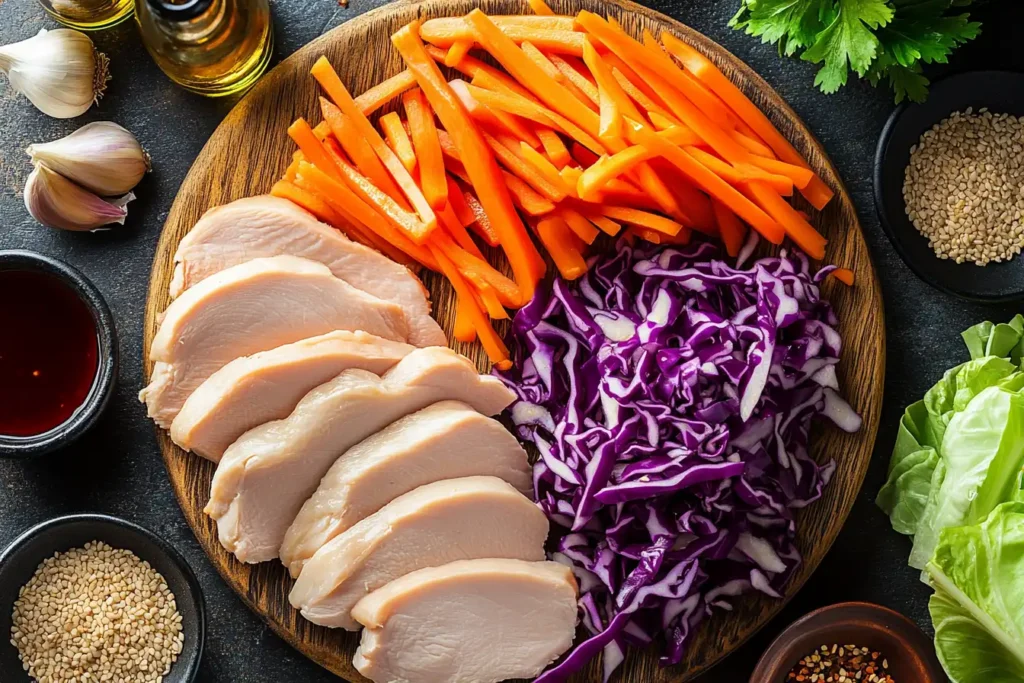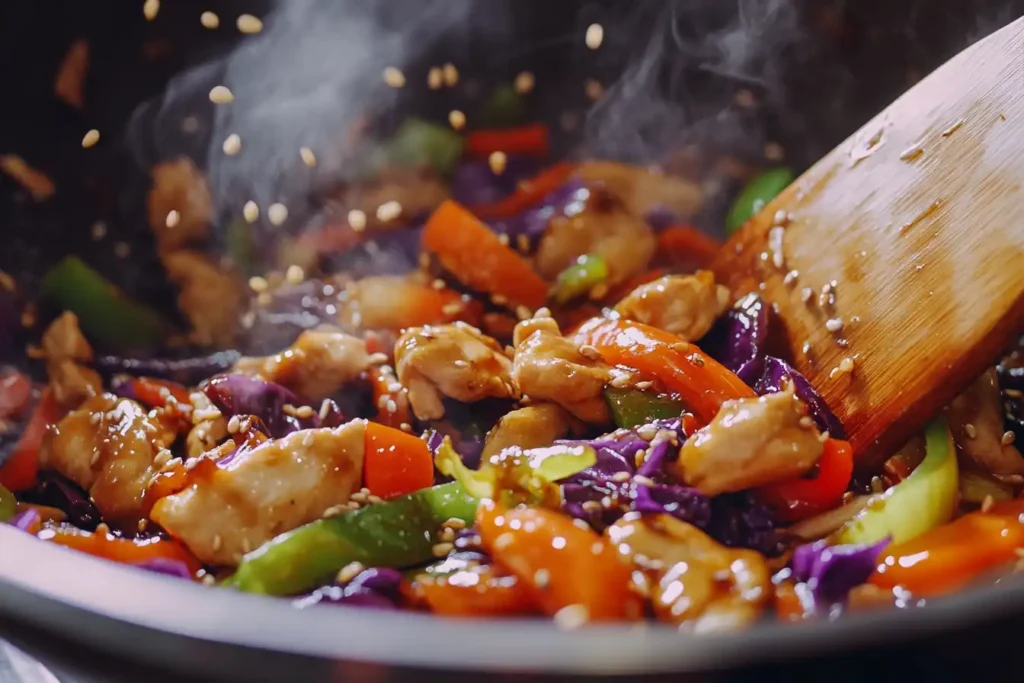When it comes to quick, healthy, and downright delicious meals, few dishes can hold a candle to chicken cabbage stir fry. This simple yet flavor-packed recipe combines tender chicken, crispy cabbage, and a symphony of colorful vegetables, all brought together with a savory, slightly tangy sauce. But it’s not just about taste—this dish is as versatile as it is nutritious, making it a favorite in kitchens around the world.
What is chicken cabbage stir fry? At its core, it’s a stir-fry dish featuring slices of chicken and shredded cabbage, often cooked alongside fresh vegetables like carrots, bell peppers, or mushrooms. Tossed in a flavorful sauce made with soy sauce, sesame oil, and aromatic spices, it’s a complete meal in one pan. Whether you’re a fan of Asian-inspired recipes or simply looking for something fast and wholesome, chicken cabbage stir fry delivers.
So, why is it so popular? For starters, it’s a time-saver. From prep to plate, you can whip up this dish in under 30 minutes. Moreover, it’s highly customizable, adapting effortlessly to different diets, tastes, and preferences.
Why You Should Try Chicken Cabbage Stir Fry
If you’ve ever searched for a meal that’s both fast and fulfilling, look no further than this dish. Let’s face it, weeknights can be chaotic, but a quick stir-fry saves the day. With just a few pantry staples and fresh produce, you can effortlessly create a hearty, home-cooked meal without breaking a sweat. Moreover, this simple combination of ingredients saves time while still delivering exceptional flavor.
The nutritional profile of chicken cabbage stir fry is another big win. Lean chicken provides a rich source of protein, while cabbage and vegetables offer essential vitamins, minerals, and fiber. Plus, it’s naturally low in carbs and fits perfectly into low-carb and keto-friendly meal plans. And, oh boy, talk about being adaptable! Whether you prefer it spicy, garlicky, or loaded with veggies, there’s a version of this dish for everyone.
Essential Ingredients for Chicken Cabbage Stir Fry
To create a truly mouthwatering chicken cabbage stir fry, selecting the right ingredients is absolutely paramount. In fact, each element, from the protein to the vegetables and sauce, plays a crucial role in delivering a harmonious blend of flavors and textures. Furthermore, paying attention to these details ensures a perfectly balanced and delicious dish.
Key Ingredients

Chicken
When it comes to choosing chicken for your stir fry, both chicken breasts and thighs have their merits. If you prefer a leaner option, go with chicken breasts—they cook quickly and absorb the sauce well. However, chicken thighs offer a juicier and more flavorful result, making them a favorite among many stir-fry enthusiasts. Slice the chicken into thin strips to ensure even cooking.
Cabbage Varieties
Cabbage is undoubtedly the star vegetable here, and the variety you choose can truly transform your dish. For example, green cabbage is the most common choice because it offers a slightly sweet flavor and a tender crunch that complements the other ingredients perfectly. For a milder taste, opt for Napa cabbage, which cooks faster and has a softer texture. Red cabbage adds a splash of color and a subtle earthiness, perfect for a vibrant presentation.
Supporting Ingredients
Aromatic Additions
No stir fry is complete without the bold flavors of garlic and ginger. These two aromatics form the base of the dish, infusing it with a distinct and irresistible fragrance.
Essential Condiments
Soy sauce, which is the cornerstone of stir-fry sauces, provides a savory, umami kick that elevates the dish. Additionally, you can add sesame oil to bring a nutty depth that seamlessly ties the flavors together. Furthermore, if you enjoy a touch of heat, you can easily sprinkle in some chili flakes or fresh chili slices to give the dish an extra spicy edge. As a result, these ingredients work harmoniously to create a well-rounded and flavorful stir fry.
Optional Add-Ons
Feel free to add more veggies for variety and texture. For instance, carrots lend a touch of sweetness, while bell peppers bring vibrant color and a satisfying crunch. Additionally, mushrooms add an earthy undertone that enhances the overall depth of flavor.
Sauce Preparation
The secret to a great chicken cabbage stir fry lies in the sauce. Here’s a quick step-by-step guide:
- Mix 2 tablespoons of soy sauce, 1 tablespoon of sesame oil, and 1 teaspoon of cornstarch (for thickening) in a small bowl.
- Add a splash of rice vinegar for tanginess and a pinch of sugar to balance the flavors.
- For a spicy kick, stir in a teaspoon of chili paste or Sriracha.
Flavor Tips
Want to tweak the taste? If it’s too salty, add a bit of water or broth. Prefer it sweeter? Drizzle in some honey. The beauty of this sauce is its versatility—it can be tailored to suit any palate.
Prepping the Ingredients for Success
Preparation is the key to a flawless stir fry. By organizing your ingredients beforehand, you’ll ensure a seamless cooking process where nothing gets overcooked or under-seasoned.
Chicken Preparation
Cutting chicken properly is essential for a quick, even cook. Use a sharp knife to slice the chicken into thin, uniform strips. For easier cutting, slightly freeze the chicken for 15–20 minutes before slicing.
Marination Tips
Marinating the chicken adds a deeper flavor. Toss the slices in soy sauce, a dash of sesame oil, and a pinch of garlic powder. Let it sit for at least 15 minutes—longer if you have time.
Cabbage and Vegetable Prep
Slicing Cabbage
For perfectly cooked cabbage, slice it thinly using a sharp knife or mandoline. This ensures it cooks quickly and evenly, maintaining its crunch.
Chopping Other Vegetables
While you can pre-chop veggies ahead of time, fresh chopping yields the best taste and texture. Aim for uniform pieces so they cook at the same rate. If you’re short on time, bagged, pre-sliced vegetables can be a lifesaver—just check that they’re fresh and crisp.
By having all your ingredients prepped and ready to go, you’ll be able to focus on the fun part—stir-frying everything to golden, sizzling perfection. Ready to dive into cooking? Let’s move to the next part!
How to Make Chicken Cabbage Stir Fry – Step-by-Step Guide
Cooking a flawless chicken cabbage stir fry might seem intimidating at first, but it’s a straightforward process once you understand the basics. By following this step-by-step guide, you’ll achieve a dish that’s bursting with flavor, packed with nutrients, and beautifully textured. Let’s dive in!
Equipment Needed
The Best Type of Wok or Skillet
The secret to a great stir fry starts with the right cookware. A traditional wok is ideal because of its wide, sloped sides, which allow for even heat distribution and quick cooking. However, if you don’t have a wok, a large, heavy-bottomed skillet works well, too.
Why High Heat Is Essential
High heat is crucial in stir-frying—it cooks the ingredients quickly, locks in flavor, and maintains the crisp texture of vegetables. Low heat can result in soggy, overcooked components, so crank up the flame and let your pan get scorching hot.
Step 1: Preheat Your Pan
Before you start cooking, preheat your wok or skillet over high heat. Once hot, add a tablespoon of cooking oil with a high smoke point, such as vegetable, peanut, or canola oil. You’ll know the oil is ready when it begins to shimmer and slightly smoke. This ensures that the chicken sears perfectly and doesn’t stick to the pan.
Step 2: Cooking the Chicken
Now, it’s time to cook the chicken:
- Add the marinated chicken slices to the hot pan in a single layer.
- Let them sit undisturbed for about 2 minutes to develop a golden-brown crust.
- Flip the pieces and cook for another 2–3 minutes until fully cooked and no longer pink inside. Remove the chicken from the pan and set it aside.
Step 3: Adding the Vegetables
With the chicken set aside, it’s time to focus on the vegetables:
- Add another drizzle of oil to the pan if needed, then toss in the minced garlic and ginger. Sauté for about 30 seconds until fragrant.
- Next, add the shredded cabbage and any other vegetables you’re using, like carrots or bell peppers.
- Stir-fry the veggies, stirring constantly to prevent burning. Cook for 3–4 minutes, just until they start to soften but still retain a slight crunch.
Step 4: Combining Everything

Finally, it’s time to bring the dish together:
- Return the cooked chicken to the pan, along with the stir-fry sauce you prepared earlier.
- Toss everything together, ensuring the chicken and vegetables are evenly coated with the sauce.
- Let it cook for 1–2 minutes, allowing the sauce to thicken slightly and the flavors to meld.
Remove the pan from heat, and your chicken cabbage stir fry is ready to serve!
Tips and Tricks for the Perfect Stir Fry
Creating a stir fry that’s both visually appealing and delicious requires a few key techniques. Let’s explore these tips to help you master the art of stir-frying:
Maintain High Heat
High heat is the cornerstone of stir-frying. It ensures that the ingredients cook quickly while retaining their texture and color. Adjust the flame as needed to keep the pan hot but avoid burning.
Prep Everything in Advance
Once you start stir-frying, there’s no time to chop or measure. Have all your ingredients prepped and within arm’s reach before turning on the heat.
Don’t Overcrowd the Pan
Overcrowding leads to steaming instead of stir-frying. If you’re making a large batch, cook the chicken and vegetables in smaller portions, then combine them at the end.
Avoid Overcooking Vegetables
One of the charms of a great stir fry is the crisp texture of the vegetables. Cook them just until they’re tender-crisp to preserve their flavor and nutritional value.
Use a High-Smoke-Point Oil
Cooking oils with low smoke points, like olive oil, can burn quickly at the high temperatures needed for stir-frying. This can negatively impact both the flavor and texture of your dish.
Therefore, it’s best to choose oils like canola, avocado, or peanut oil. These options can handle high heat without breaking down, ensuring even cooking and excellent flavor.
Adjust Seasoning at the End
Taste your stir fry before serving and adjust the seasoning if needed. A little extra soy sauce, sesame oil, or chili flakes can make a big difference.
Creative Variations of Chicken Cabbage Stir Fry
One of the best things about chicken cabbage stir fry is its versatility. With a few tweaks, you can transform this dish into something entirely new while maintaining its wholesome appeal. Here are some exciting ways to make it your own.
Protein Swaps
Shrimp:
For seafood lovers, shrimp is an excellent substitute for chicken. It cooks quickly and brings a mildly sweet, oceanic flavor to the dish. Just toss cleaned shrimp into the hot wok and sauté until pink before setting them aside.
Tofu:
For a vegetarian-friendly option, firm tofu is a top choice. Dice the tofu into cubes and pan-fry until golden. It soaks up the sauce beautifully, providing a satisfying bite.
Beef:
Thinly sliced beef, such as flank or sirloin, adds a rich, hearty flavor. Marinate it in soy sauce and cornstarch to keep it tender and flavorful, then cook it in high heat for a quick sear.
Vegetarian and Vegan Options
Creating a plant-based version of chicken cabbage stir fry is simple. Replace the chicken with tempeh, jackfruit, or seitan for a hearty, meat-free dish. Use tamari or coconut aminos instead of soy sauce, and ensure all your sauces are vegan-friendly.
Sauce Customizations
Take the flavors to the next level by modifying the sauce:
- Oyster Sauce: Deepens the umami flavor with its savory richness.
- Hoisin Sauce: Sweet and tangy, it adds a bold character to the dish.
- Peanut Butter: Adds a creamy texture and a nutty flavor that pairs well with crunchy veggies.
Want more heat? Add chili flakes or sriracha to spice things up.
Add-ons for Extra Nutrition
Elevate the nutritional value of your stir fry by including a variety of vegetables:
- Broccoli: Adds fiber, vitamin C, and a hearty crunch.
- Snap Peas: Their natural sweetness and crisp texture make them a great addition.
- Spinach: Stir in fresh spinach at the end for a quick, nutrient-packed boost.
These simple variations make chicken cabbage stir fry endlessly customizable to suit any craving or dietary need.
Nutritional Highlights of Chicken Cabbage Stir Fry
Packed with lean protein, fresh vegetables, and a flavorful sauce, chicken cabbage stir fry isn’t just delicious—it’s a powerhouse of nutrition. Let’s break down the key benefits.
Protein-Packed Chicken
Chicken is the main protein in this dish, offering essential amino acids that aid in muscle growth and repair. It’s also a low-fat option, keeping you full and satisfied without unnecessary calories.
Nutrient-Rich Cabbage
Cabbage shines as the hero vegetable. It’s high in fiber, promoting digestion, and loaded with vitamins like C and K, which support immune health and bone strength. Plus, its low-calorie profile makes it ideal for weight management.
Balanced Meal
Chicken cabbage stir fry fits seamlessly into a variety of diets, from keto to gluten-free. Its combination of protein, veggies, and healthy fats creates a balanced meal that satisfies hunger while providing essential nutrients.
Whether you’re looking for a wholesome dinner or a quick, nutritious lunch, this dish has got you covered!
Best Ways to Serve Chicken Cabbage Stir Fry
The versatility of chicken cabbage stir fry doesn’t stop with the ingredients. How you serve this dish can elevate your dining experience, transforming it from a simple meal into a complete culinary delight. Let’s explore some ideal pairings.
Pairing with Steamed Rice, Noodles, or Quinoa
Steamed Rice:
Fluffy white rice is a classic accompaniment to stir fry. Its neutral flavor balances the bold, savory notes of the dish, making each bite feel complete. For a healthier twist, opt for brown rice or cauliflower rice.
Noodles:
For a more indulgent option, pair your stir fry with noodles like egg noodles, soba, or rice noodles. Toss them directly into the stir fry for a one-pan meal or serve them on the side.
Quinoa:
Looking for a high-protein, gluten-free option? Quinoa is an excellent choice. Its nutty flavor complements the savory stir fry while adding an extra layer of nutrition.
Ideal Side Dishes
Pair your chicken cabbage stir fry with some crispy spring rolls or a warm bowl of wonton soup for a satisfying meal. For dessert, try something sweet and classic, like these delicious Quaker Oatmeal Cookies, to round out your dinner experience
Frequently Asked Questions About Chicken Cabbage Stir Fry
What type of chicken is best for stir fry?
Boneless, skinless chicken breasts are a lean and tender option, while chicken thighs provide extra juiciness and flavor. Both work well, so choose based on your preference.
How do you cut cabbage for stir fry?
To cut cabbage for stir fry, remove the tough outer leaves, slice the head in half, and cut out the core. Then, use a sharp knife or mandoline to shred the cabbage into thin, even strips for quick and even cooking.
Should I blanch cabbage before stir fry?
Blanching cabbage isn’t necessary for stir fry. The high heat of stir-frying is enough to cook the cabbage while retaining its crisp texture and vibrant flavor.
Which cabbage is better for stir fry?
Green cabbage is the most common choice due to its mild flavor and firm texture. Napa cabbage cooks faster and offers a softer bite, while red cabbage adds a unique color and slightly earthy taste.
Do you stir fry chicken or vegetables first?
Always cook the chicken first to ensure it’s fully cooked and has a golden-brown crust. Remove it from the pan, then stir fry the vegetables. Combine everything in the final step for a well-blended dish.
Do you wash cabbage before or after cutting?
Wash cabbage after cutting. Shredding the cabbage first makes it easier to rinse away dirt or debris. Use a colander and cold water to ensure thorough cleaning.
How long does cabbage take to boil?
Cabbage typically takes 3–5 minutes to boil, depending on the size of the pieces. However, boiling isn’t required for stir fry—high-heat cooking in the wok is faster and preserves the cabbage’s texture and nutrients.

